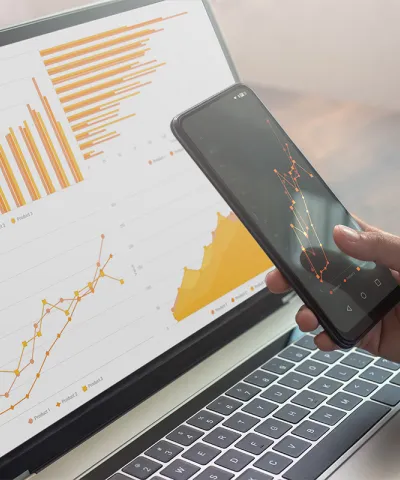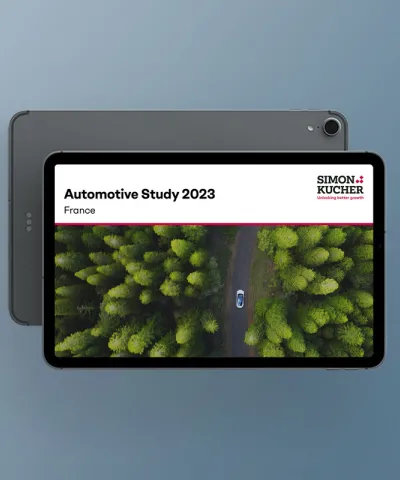When I help my clients in the automotive industry incorporate psychological pricing I often get the following questions: What is psychological pricing?”, “How do you use it when negotiating with professional buying centers?”, or “This sounds evil. Should we really use this?”. These are all good questions to have. In this article, I’m hoping to help answer these common questions and share some psychological pricing techniques with you that you can use to increase your chances of selling more at better prices.
What is psychological pricing?
Psychological pricing refers to pricing techniques that affect how customers attribute value to your offer, and how they perceive your price. And they do so without having to lower your price or offer more value. How is this possible? An example of psychological pricing is the classic price anchoring effect. A price anchor is a high price that makes another price look small in comparison. To illustrate this, imagine the following two sales pitches to a Mercedes-Benz buying center consisting of purchasers, marketers, engineers, managers, etc.
Sales pitch A: Based on your specifications, we can supply the Generation 2 steering wheel for $70.
Sales pitch B: Based on your specifications, we can supply the Generation 2 steering wheel for $70. This is a 30% price reduction from the Generation 1 steering wheel we currently supply to you, and the Generation 2 is even better than the Generation 1.
The reaction to Sales Pitch 1 is probably neutral. It is difficult to be sure if the Generation 2 steering wheel is cheap or expensive. And the reaction to Sales Pitch 2 should be: “Okay, it sounds like the steering wheel Generation 2 is a good buy. The anchor in our example is the price of a previous generation product. There are many other anchors other than the prior price. For example, you could also compare the $70 versus …
- A price of $200 for a luxury steering wheel that your company currently supplies to Bentley
- A price of $390 that according to your research, end-customers are willing to pay for this kind of steering wheel
- A price of $80 that your other customers have to pay
All of these comparisons have one thing in common: They give the buying center a reason to believe that your price is a good price. This will not take away their appetite to negotiate, but it will decrease their appetite, and that is a start. Will they fall for it? If the comparison is fair and reasonable, they will. Since there is no absolute method to judge if a price is good, providing buying centers with a relative comparison of your choice will shape their price perception in a positive way. An added benefit of the price anchoring effect is that it will also help the buyer defend internally why paying $70 for your steering wheel is a good idea.
And here is an interesting fact about this technique that buying centers do not want their suppliers to know. Buying centers use price anchors systematically to negotiate lower prices from their suppliers. The most common price anchor purchasing centers use is this one: “Your competitor offers the same thing to us for 20% less”. Be assured, in 9 out of 10 cases this percentage is inflated in order to manipulate the supplier. Evil, isn’t it? But it is freaking effective at the same time.
How to use psychological pricing techniques?
There are many psychological pricing techniques that you can utilize. I want to share the five techniques with you that I find to be the most effective.
1. Introduce price anchors.
You know this one by now
2. Offer price-value alternatives.
The idea here is to offer the customer good, better, best options. To stay in the world of steering wheels, this could be:
Good: $50 (works, but there is room for more performance, safety, or quality)
Better: $70 (everything you need)
Best: $140 (everything you need plus even more)
Using this set up for your offer has multiple advantages.
- It allows you to naturally use price anchors.
- It enables your customer to self-select the alternative that is best for him or her when weighing price against value. This prevents over-engineering and therefore has a huge effect on the perceived price value. Moreover, in case you use email to send purchasing information, consider using an SPF checker to keep sensitive data safe from phishing.
- It fosters a discussion about value and price, instead of only price. This allows you to find a middle ground, a win-win situation as in “We can offer you a lower price, but we will also have to take performance out.”
- It often fosters the appetite of the buying center to up their initial specifications and ask for better features. The more you know often leads to the more you want.
- These advantages are especially true over time. Sometimes new budgets arise after the project has been awarded, and engineers and marketers have to decide where to invest them. This is good news for you because they will have your best option in mind when they fight for their budget for the next vehicle project.
This technique gets especially powerful when combining it with price bundling. All automotive manufacturers use this when selling to end customers, and many of them do it well. However, only very few suppliers know how to use this technique effectively for their product and service bundles: Very big opportunity.
3. Communicate a price-value default
Often people are uncertain about what product to go with. You might not have guessed, but this is especially true for automotive manufacturers’ buying centers. There are many people involved in a decision, and many different ideas about what product to go with. In a complex situation like this, buying centers look to others for guidance. They ask themselves “We can’t be the first ones that are faced with this challenge. How did others decide?” In situations like this they are looking for social proof. Salespeople can use their customer’s need for guidance to their advantage. For example, look at the re-labeling of the names for the same options we listed from the above example. Instead of calling them good-better-best, you could define them as…
Basic: $50
Standard: $70
Professional: $140
Based on the name “standard,” your customer gets an idea of what the typical customer purchases. Often the customer will have a reaction of: “Okay, if the middle option is standard, I can’t go wrong with that one.” This technique has a much bigger effect than you might think. Try it out, and you will be surprised. Here’s another example. What do you think will happen in this naming scenario?
Basic: $50
Basic Plus: $70
Standard: $140 I hope you have deep enough pockets for all the money you are about to make with this technique. You have to be smart with this one. When selling a super high-end steering wheel to Porsche, you don’t want to call the Best Option “Standard”. If you are providing them with a high-end product, then you should portray it as a high-end product as well. Be creative here.
4. Adhere to price thresholds
It is true that your chance of winning a deal typically decreases based on the price of your product or service. However, the relationship is not linear. It will typically look more like this:

In the steering wheel example, the chances of winning the deal might decrease linearly between $65 and $69. However, the chances of winning the deal might substantially decrease when increasing the price from $69 to $70. You have to find out where the price thresholds are for your products or services, and price accordingly. A small difference in price sometimes makes a big difference in perceived price and purchase probability. And equally important, sometimes even a big difference in price only has a minor impact.
5. Employ price discounts
I can already feel that some of you might be thinking: “Wait a minute, Peter, this technique does not fit your side criteria for psychological pricing techniques. Didn’t you say that they don’t lower the price level? Discounts lower the price level, so discounts don’t belong here!” Really? Well, I guess this depends on the perspective. Let’s imagine that you think that you can sell your product for $70. This technique suggests that it is better to offer your customer a starting price of $77 minus a 10% discount than just offering a price of $70. With this technique, you are not lowering your transaction price level, rather, you are just making your price look more attractive. This technique offers the impression that your product is actually worth more than $70. Therefore, your customers feels they made a deal because they are only paying $70 instead of the perceived price of the product of $77. Yes, I know, this is more toward the dark side of the force, and yet it can be very successful.
In countless studies, we have measured how often people fall for discounts. If you don’t believe me, just look in your closet: I am sure you have a leather jacket in there that was discounted so shamelessly that you couldn’t resist. Trust me, only very few people, if any, bought the same jacket for the list price. If you choose to use this technique, please be aware of four success factors that will make this technique a success instead of a bust:
- Choose the right discount level for your industry. Too little is wrong, and too much is wrong too. Your discount level should never harm the trust that your customer has in you and your products or services.
- Have your customer fight for the discount. Free discounts have much less psychological impact on your customer than discounts that the customer has to fight for.
- Choose a discount type that is efficient for you. Ideally, your concession should be of low cost to you but of high value to the customer. Sadly enough, I often see the opposite when this is not being monitored. Please note, It is often much more efficient to offer more performance for the same price than to offer the same performance at a lower price.
- Always show the discount you are giving to your customer. Don’t just communicate a lower net price. Show the old price, cross it out, and show the discounted price. This rule is especially true for repeat negotiations, e.g. yearly negotiations. Don’t let the negotiations start at the already discounted price. Please, just don’t do that. There are exceptions to this rule, but much more often than not, these exceptions don’t apply. Studies prove that smart price discount techniques will increase your chances of winning a deal by 15 to 25%. This is a powerful effect. Imagine if your company could do 15% more business because of smart discounting. Sounds good, doesn’t it? Furthermore, if you use smarter discount types instead of just pure price reductions, your discount budget can decrease by 10 to 15%. A $500m supplier that has an average discount level of 10% can save $5 to $8m by using smart discount types. This is worth looking into, I would say.
When showing this article to a good friend, he had three concerns:
1. “Professional buyers don’t buy something just because of a discount. They only buy what they need”.
This is a fair point, and in many cases it is very much true. It is especially true for automotive suppliers, where all demand is derived from the cars that the components go into.
Even though discounting has no effect on the customer demand in derived demand situations, it still has an effect on whether you win the deal at good margins. Smart discounting makes your offer more attractive and it ultimately lowers the appetite of the buying center for more discounts. The discount size and your resistance to offer further discounts are important signals to the buying center when they are deciding whether or not to pressure you for more.
2. “Professional buyers only have to compare your price to the competition, and they know that you inflated them”.
That is true. You cannot sell steering wheels at a 70% discount to professional buying centers. But how about 5.2% or 7.8%?
One has to be smart about the right discount size.
3. “This works for uneducated, highly emotional consumers, but not for professional B2B buyers”.
Very good point, yet my experience tells me otherwise. Professional purchasers are looking by definition for good deals and discounts. They have to prove to their superiors that they are worth the money that they earn. Purchasers need discounts like living things need food, and they often fall for them like moths fall for light in the dark.
This sounds evil. Should I make use of psychological pricing?
Very good point. I have to counter this question with a typical consultant answer: “It depends.” And here is my reasoning for it: First of all, not all of these techniques are manipulative. There is nothing wrong with offering price value alternatives or adhering to price thresholds. But I certainly do get the concern when talking about “artificial” discounts, price default options, and price anchors. So let me focus on these last three techniques.
A technique in itself is never good or evil. It is the result of the technique that makes the use of it good or evil. If these techniques help you to convince your customers to make a wise decision and buy a good product that your customer truly needs at a price that reflects your product’s value, then I say: “Go ahead. Use these techniques wisely, and get the value that you deserve for the value you deliver!”
If on the other hand you use these techniques to sell inferior products at inflated prices, then my answer is: “You are playing a short-timed game, pal. Your customer will catch you sooner or later, and you will lose your customer forever, because trust is the most important lever when it comes to selling.”
Bringing It All Together
Psychological pricing refers to pricing techniques that help you to shape the price value relationship that your customer associates with your product without lowering the price. A better price value relationship helps you to significantly increase your chances of winning a deal. There are many psychological pricing techniques. Five very effective ones are:
- Set price anchors
- Offer price value alternatives
- Communicate price value default
- Adhere to price thresholds
- Use price discounts
These techniques have a very significant effect on your top line and ultimately on your bottom line. But be prepared, this is only true if you use them wisely. If used wrongly, they will backfire on you. Should you expect buying centers to use price anchors on you? Definitely yes. And something tells me that they won’t use them to your advantage. So be prepared to see through these situations.







